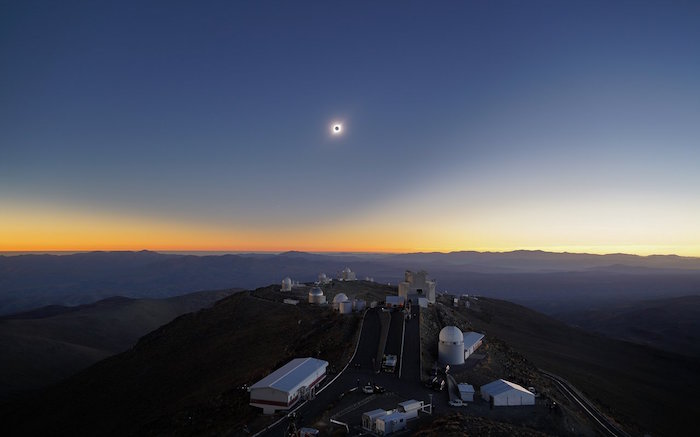La Silla 50th anniversary culminates with total solar eclipse
Visitors enjoy outreach programme at ESO’s first observatory

Total solar eclipse, La Silla Observatory, 2019 | Image credit: ESO
On 2 July, the path of totality of a solar eclipse passed across ESO’s La Silla Observatory. This rare astronomical event falls in the fiftieth year of operation of ESO’s first observatory. Inaugurated in 1969, La Silla Observatory led Europe to the front line of astronomical research and continues to deliver remarkable science. 1000 visitors, including the President of the Republic of Chile, journeyed to the remote observatory to witness the unique conjunction.
At 16:40 CLT, the Moon covered the face of the Sun, in a total solar eclipse visible from a 150-km-wide swathe of northern Chile, including ESO’s La Silla Observatory, which celebrated half a century of astronomical research this year.
ESO, in collaboration with the Government of Chile, organised an outreach campaign that gave people the opportunity to experience this rare [1] phenomenon from La Silla Observatory itself. 1000 visitors had access to the site, including more than 30 high school students and 30 senior citizens from La Serena, La Higuera and Coquimbo, the districts neighbouring the Observatory.
Another group of students came to La Silla from all over Chile. The youngsters were selected through a contest organised in collaboration with the Chilean Ministry of Education. The students had to write a letter where they explained their interest in science and, particularly, in astronomy. The winners, each together with a parent, were rewarded with a fully paid trip to La Silla.
International and local media were also invited and about 60 representatives responded to the call. In addition, ESO webcast the eclipse online.
Eight social media users were selected from 300 participants from ESON countries to participate in the #MeetESO second edition, a social media gathering taking the winners to all of ESO’s sites. They are sharing their experience with the world on Twitter and Instagram, as well as on their own channels. A public competition dedicated to La Silla Observatory’s 50th anniversary, #LaSilla50Years, also saw one person from ESO’s Member States win a trip to Chile to visit our sites.
“People around the world made the voyage to Chile, hoping for an unrivalled view of the solar corona as the Moon passed between the Earth and the Sun, turning day into night for almost two minutes,” explains Claudio Melo, ESO Representative in Chile. “These visitors were rewarded with pristine Chilean skies and a perfect view of the solar eclipse.”
Joining the many visitors at La Silla was the President of the Republic of Chile, Sebastián Piñera, who was welcomed by ESO’s Director General, Xavier Barcons.
“We are delighted that the President chose to join us at La Silla on this very special day,” said Xavier Barcons. “The eclipse happened on the 50th anniversary of La Silla, an occasion to celebrate the strong and productive partnership between Chile and ESO. La Silla has played an extremely important role in the development of astronomy in Europe and Chile, and Chilean astronomers routinely use telescopes in La Silla for their scientific research.”
La Silla has been an ESO stronghold since the 1960s. Here, ESO operates two of the most productive 4-metre-class telescopes in the world.
The 3.58-metre New Technology Telescope (NTT) broke new ground in telescope engineering and design and was the first in the world to have a computer-controlled main mirror (active optics), technology developed at ESO and now applied to most of the world’s current large telescopes.
The ESO 3.6-metre telescope is now home to the world’s foremost extrasolar planet hunter in a ground-based observatory: the High Accuracy Radial velocity Planet Searcher (HARPS), a spectrograph with unrivalled precision.
The President enjoyed a tour of La Silla’s facilities. “We are stardust,” exclaimed the President during the event.
“Today Chile is the world capital of astronomy and for this reason to be at La Silla Observatory today is very special.”
The observatory’s regular astronomical inhabitants were also on site to take advantage of existing observing infrastructure in novel ways. Seven projects with scientific or outreach goals took place during the eclipse, with some using pre-existing telescopes at La Silla, such as the NTT, ExTrA, TAROT and REM, and others using temporary setups. This follows a long tradition of using eclipses for scientific observations, such as the famous confirmation of General Relativity which took place 100 years ago.
The partial eclipse started at 15:23:50 CLT, with totality lasting 1 minute and 52 seconds from the La Silla summit, between 16:39:23 CLT and 16:41:15 CLT. The partial eclipse ended at 17:47:16 CLT, shortly before sunset.
As the eclipse itself only occurred during the late afternoon, for the rest of the day visitors enjoyed a wide range of different activities, from tours of the La Silla telescopes to an engaging variety of talks, music and workshops. ESO astronomers and guides were on hand to engage with visitors throughout the day.
“Witnessing a total solar eclipse is a breathtaking experience that stays with you forever. Fond memories of today’s event will remain in the hearts of our numerous guests at La Silla. This has been a unique moment in this unique observatory’s history,” concluded Xavier Barcons.
The last total solar eclipse visible from La Silla took place at the end of the 16th century, and the next will not be until the year 2231.
Links
- Total solar eclipse website
- Total solar eclipse webcast
- Scientific projects during the eclipse
- La Silla Observatory 50th anniversary
Notes
[1] Total solar eclipses are rare phenomena, occurring on average once every 360 years at any specific location.


